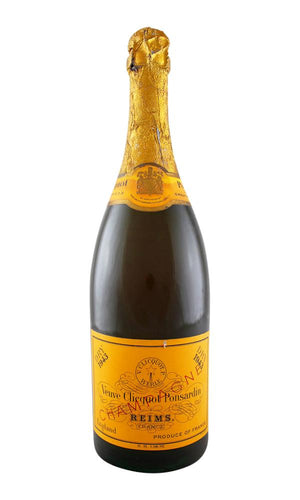- Our Shop

$2,598.99
Boasting a creamy nose and a crisp and refreshing palate, this is a Champagne of pure elegance.
Order from the Largest & Most Trusted Premium Spirits Marketplace!
Featured in
NOTICE: Many other small liquor store sites may end up cancelling your order due to the high demand, unavailability or inaccurate inventory counts. We have partnerships consisting of a large network of licensed retailers from within the United States, Europe and across the world ensuring orders are fulfilled.
Producer: Veuve Clicquot
Vintage: 1943
Size: 750ml
ABV: 12%
Varietal: Champagne Blend
Country/Region: France, Champagne
Boasting a creamy nose and a crisp and refreshing palate, this is a Champagne of pure elegance.
Veuve Clicquot is one of Champagne’s best known producers, and has been a consistent seller since it was founded in 1772. Pinot Noir has dominated over Chardonnay and Pinot Meunier in this blend from its inception. The house famously invented the process of riddling, which removed the dead yeast cells and gave the finished wines a clear appearance. The house was founded by Philippe Clicquot in 1772 as a sideline to his successful textile business, but became the second largest producer of Champagne in the region under his daughter-in-law, Barbe-Nicole Ponsardin. In 1798 Philippe Clicquot married his only son, Francois, to the daughter of a prominent local business man named Ponsardin as a way to consolidate the power of both his and Ponsardin’s successful businesses. Francois and his wife, Barbe-Nicole, saw an opportunity to take over the wine business and hopefully foster its growth. The attempt failed miserably due to the outbreak of the Napoleonic Wars, and Francois Clicquot died in 1805. Barbe-Nicole continued on her own and, with the help of investments from her father-in-law and some deft smuggling of wines to Tsar Alexander I of Russia, Veuve Clicquot exploded onto the market. The development of the riddling process meant production increased significantly, which was able to satiate demand. Today, Veuve Clicquot Ponsardin is owned by luxury giant Louis Vuitton Möet Hennessy (LVMH). The portfolio of Veuve Clicquot includes non-vintage and vintage wines in Brut, Rosé and Demi-Sec variants. The top wine is La Grande Dame, a vintage champagne first created in 1972 in honor of Barbe-Nicole, produced from a blend of eight grand cru vineyards. One of the most recent additions to the portfolio is the Rich Collection which is characterized by champagnes with a high dosage giving a sweet and round flavor profile. The Veuve Clicquot underground cellars (crayères) were originally chalk quarries established in medieval times. They stretch for more than 24 kilometers beneath colline Saint Nicaise and provide a constant temperate and humidity for aging champagne. In 2015, the cellars were listed as a Unesco World Heritage site.
Only logged in customers who have purchased this product may leave a review.
Bourbon Bridges Ltd ©2024 Privacy Policy

THE ALCOHOL PRODUCTS ON THIS WEBSITE ARE INTENDED FOR ADULTS ONLY.
By entering this website, you certify that you are of legal drinking age in the location in which you reside (age 21+ in the United States).
Reviews
There are no reviews yet.